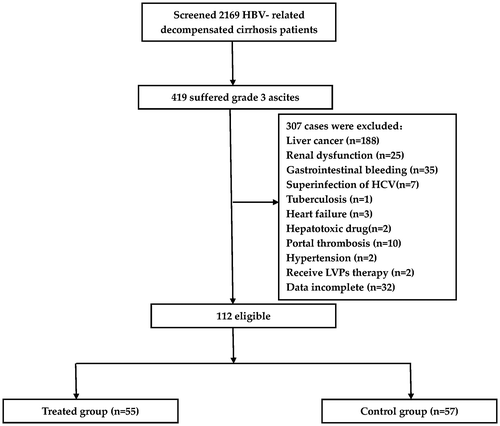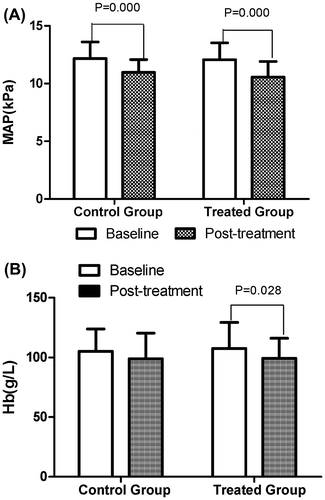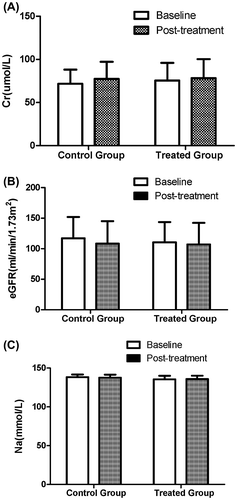Figures & data
Figure 1. Study profile. A total of 2,169 HBV-related, decompensated liver cirrhosis inpatients were screened from January 2009–January 2014. Of them, 419 had grade 3 ascites, and 112 cases were eligible, among whom 55 cases served as the treated group and received treatment with intermittent drainage of ascites by central venous catheter (PCVC therapy). The remaining 57 patients who did not receive PCVC therapy served as controls.

Table 1. Clinical and biochemical indexes of the patients at baseline
Figure 2. Comparison of baseline and post-treatment MAP and Hb between the two groups. (A) Compared with the baseline, the levels of MAP dropped significantly after treatment (control group: 82.27 ± 8.36 kPa vs. 91.25 ± 10.82 kPa, p = 0.000; treated group: 79.14 ± 10.30 kPa vs. 90.53 ± 10.97 kPa, p = 0.000) in both groups. (B) Compared with the baseline, the level of Hb in the treated group declined markedly (99.29 ± 16.78 g/L vs. 107.55 ± 21.80 g/L, p = 0.028) after treatment, while no significant difference was found in the control group (98.91 ± 21.44 g/L vs. 105.23 ± 18.57 g/L, p = 0.096).

Figure 3. Comparison of baseline and post-treatment renal function between the two groups. (A) Compared with the baseline, there was no significant difference in the level of Cr after treatment (control group: 71.81 ± 16.34 μmol/L vs. 77.44 ± 19.80 μmol/L, p = 0.100; treated group: 75.59 ± 20.31 μmol/L vs. 78.36 ± 21.93 μmol/L, p = 0.495). (B) Compared with the baseline, there was no significant difference in the level of eGFR after treatment (control group: 117.06 ± 34.86 ml/min/1.73 m2 vs. 108.37 ± 36.70 ml/min/1.73 m2, p = 0.197; treated group: 110.47 ± 33.12 ml/min/1.73 m2 vs. 107.07 ± 35.14 ml/min/1.73 m2, p = 0.602). (C) Compared with the baseline, there was no significant difference in the level of Na after treatment (control group: 138.26 ± 3.51 mmol/L vs. 137.70 ± 3.88 mmol/L, p = 0.417; treated group: 135.54 ± 4.53 mmol/L vs. 135.96 ± 4.18 mmol/L, p = 0.614).

